Select the aromatic, anti-aromatic, and non-aromatic a compounds.
1. ,2. ,3.
4. ,5
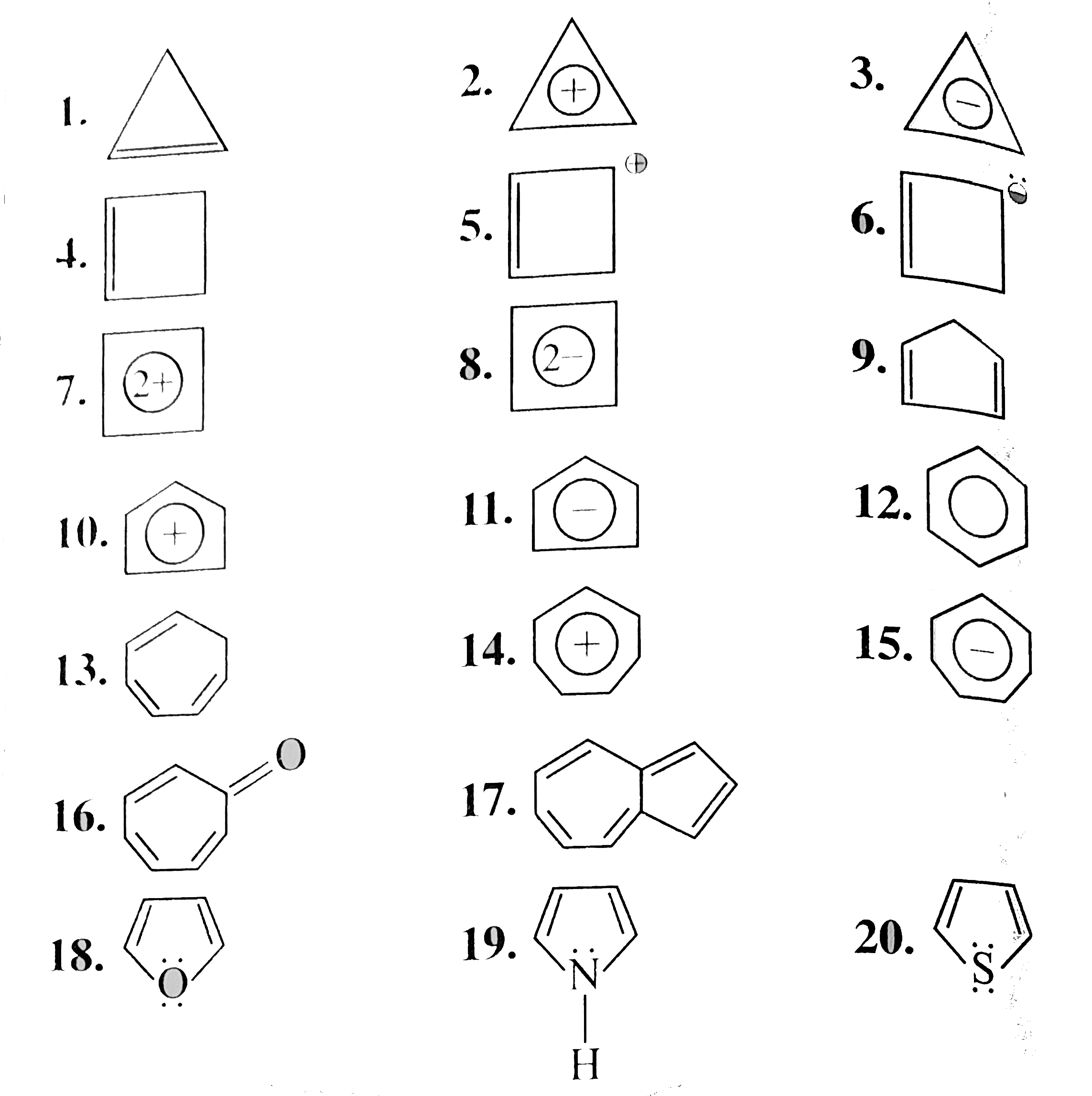
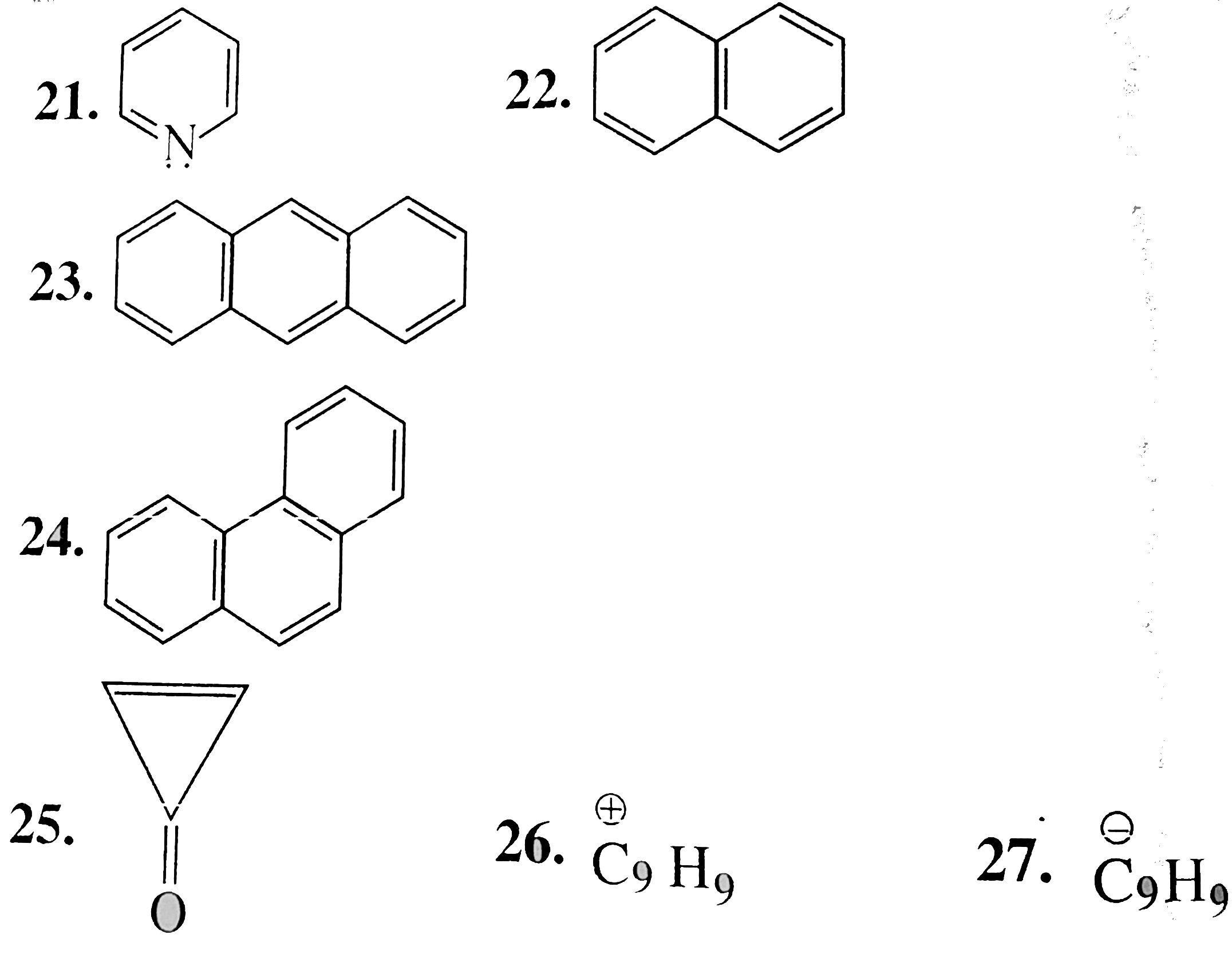
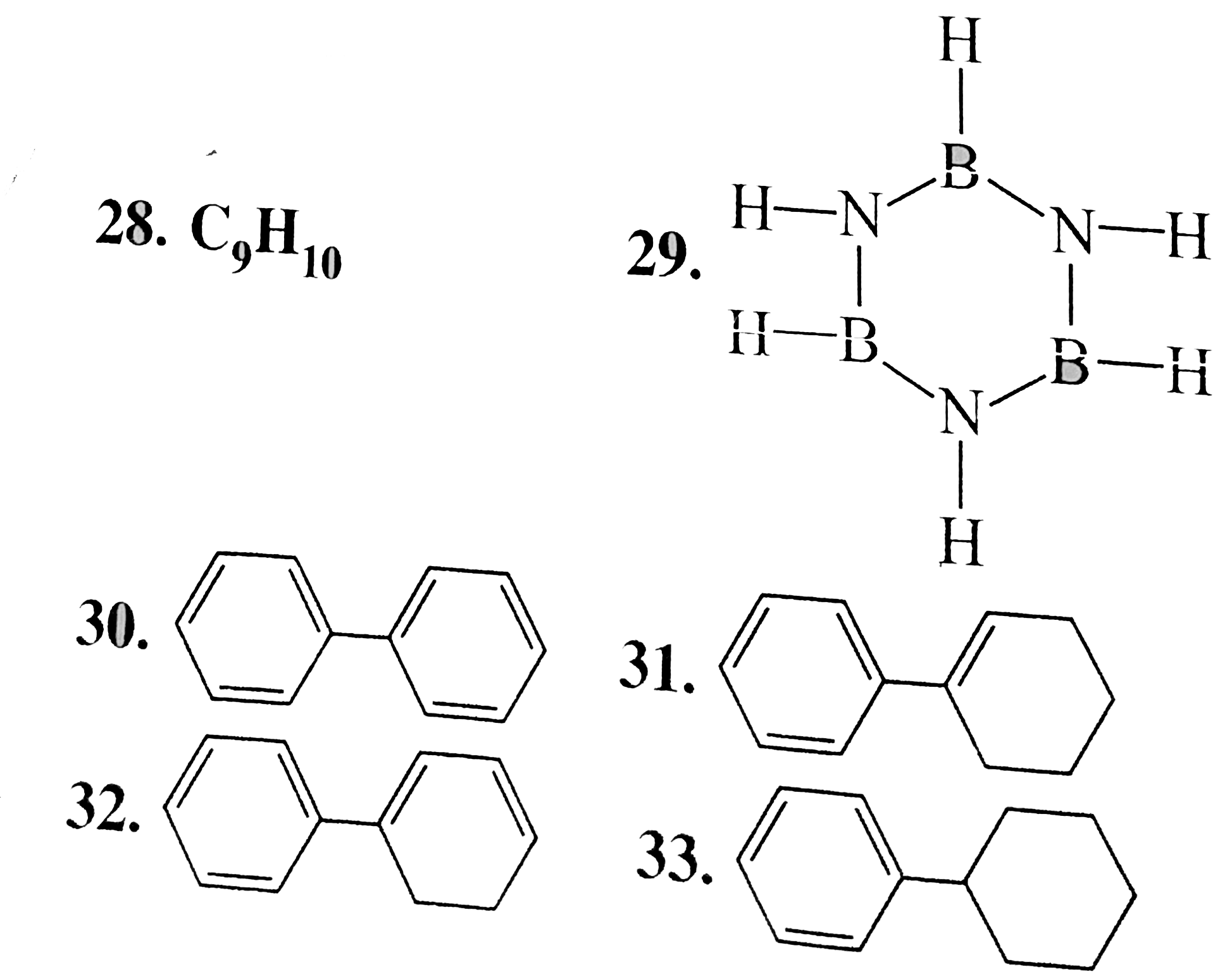
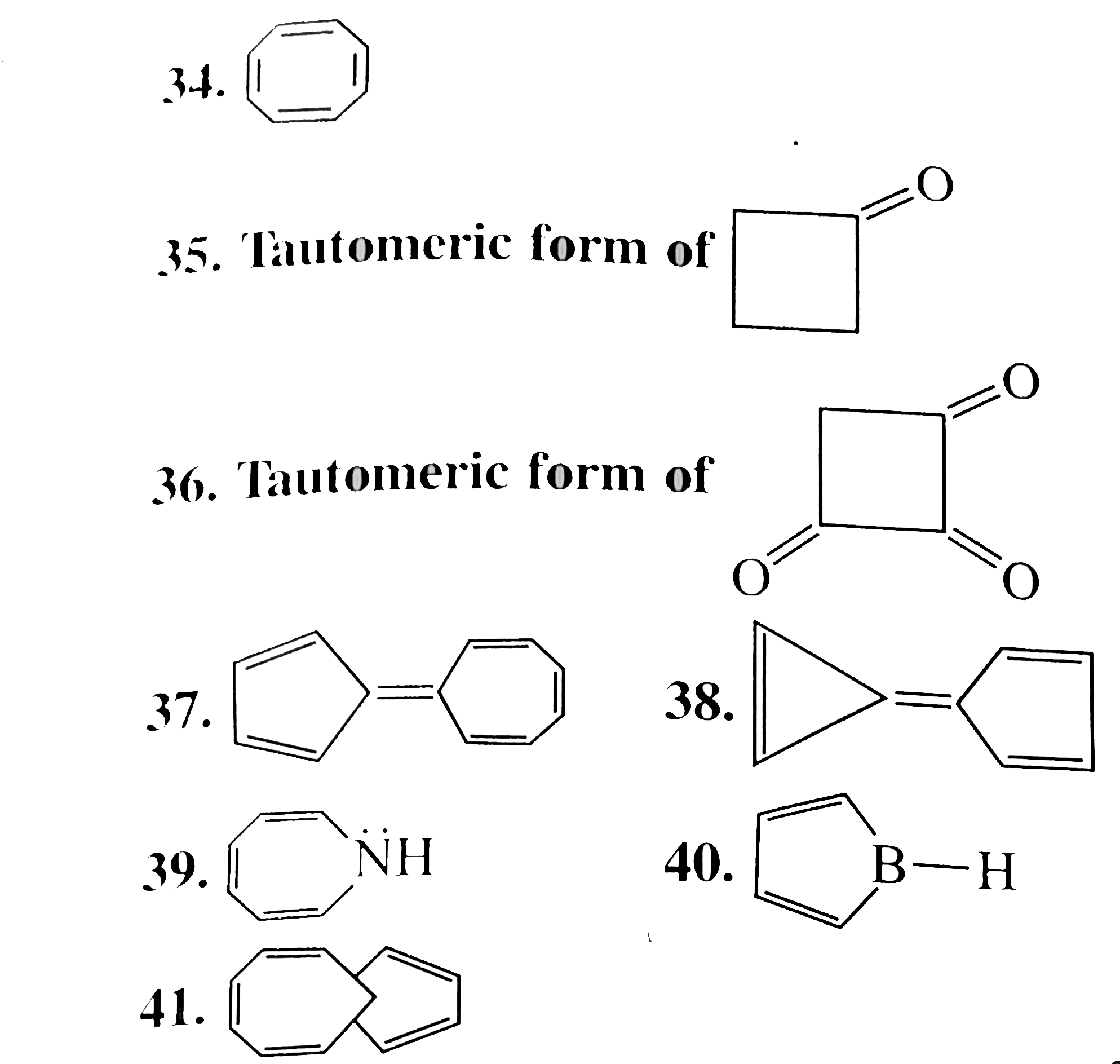
Video Solution
Text Solution
1. Non-aromic
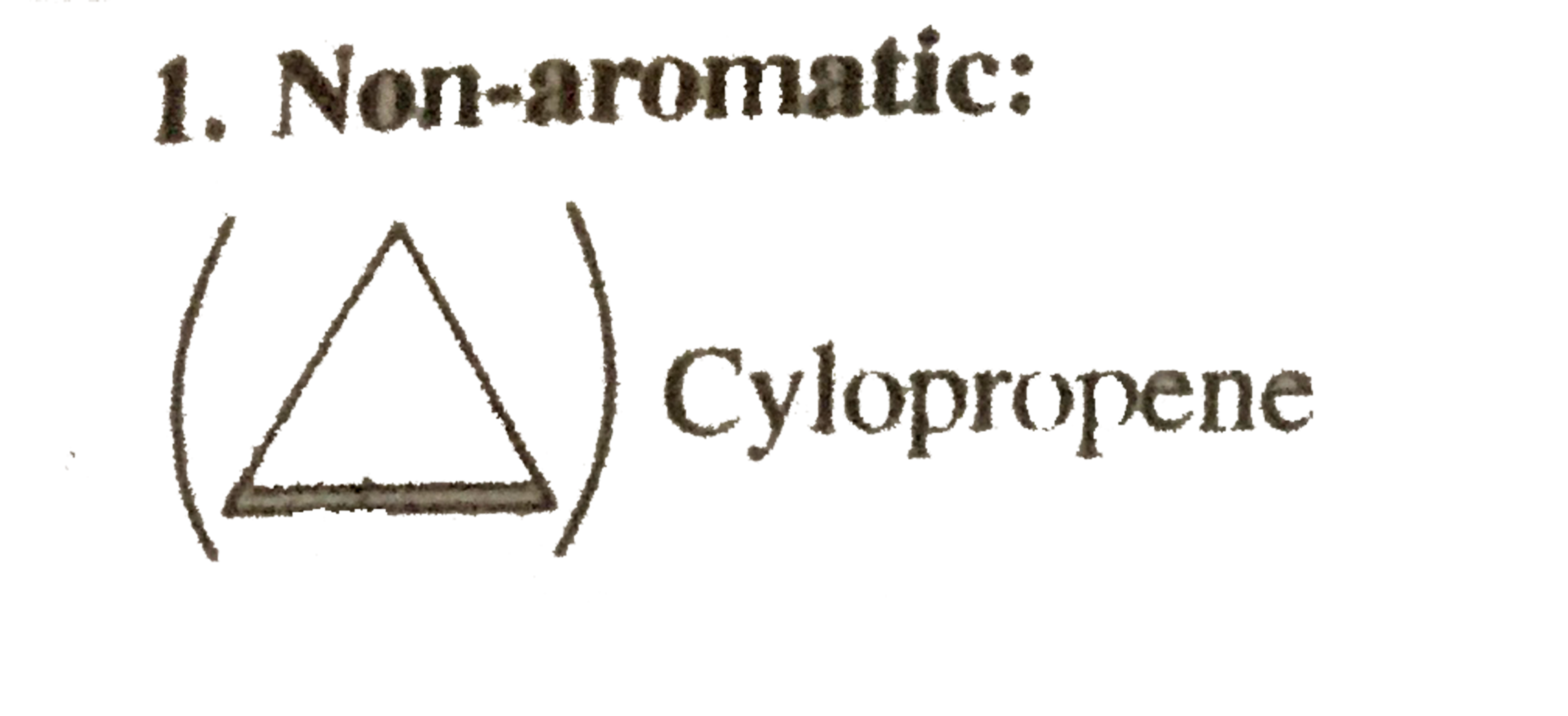 Cylopropene
Cylopropene
Cyclic, planner, 2π→es system, folows (4π+2)π→e but not in delocalisation or not in resonance.
2. Aromic:
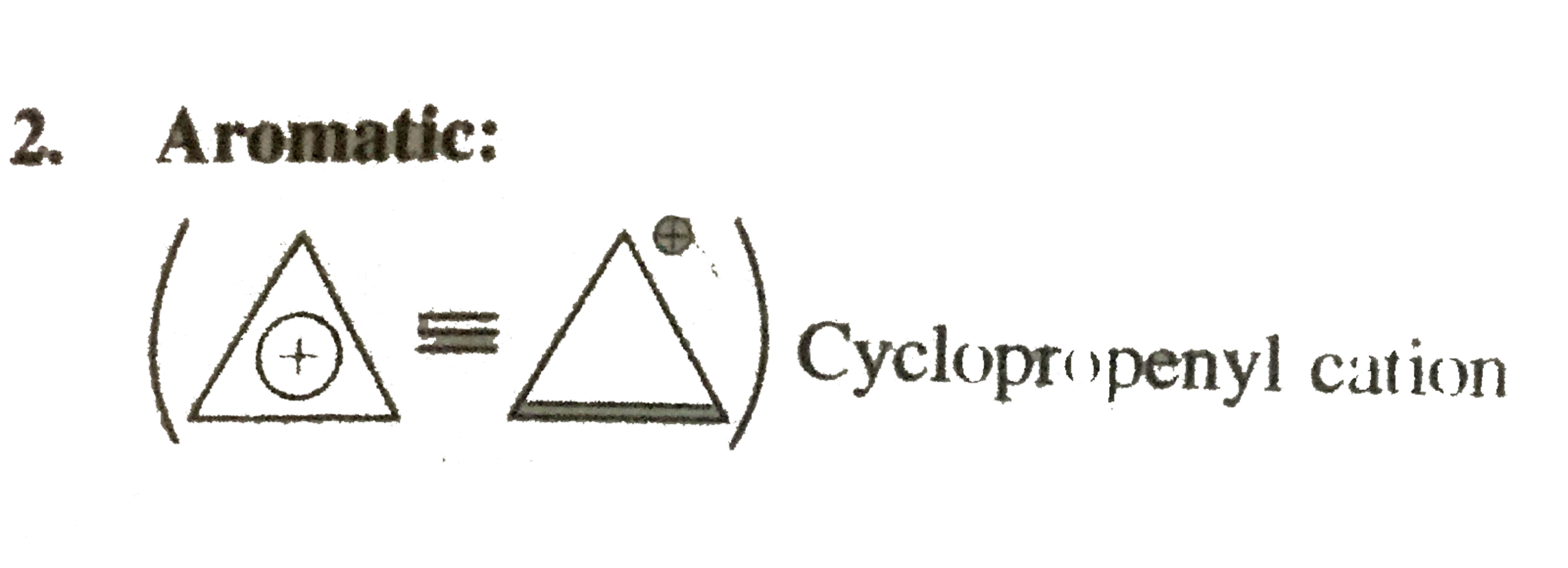 Cylopropenyl cation
Cylopropenyl cation
Cylic, planner 2π→es system follow (4π+2)π→es and 2π→es are in delocalisation or in resonance with positive charge.
3. Anti-aromatic:
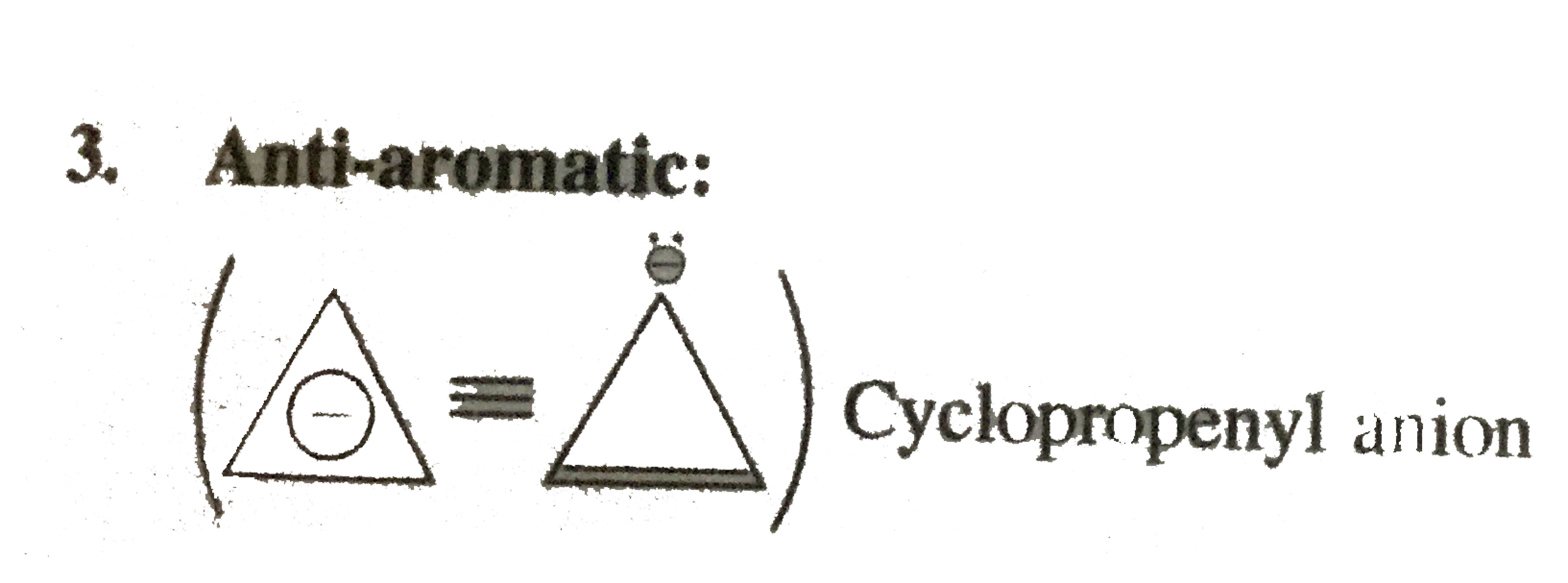 Cycloprepenyl anion
Cycloprepenyl anion
Cyclic, planner, 4→es system (2π→e+2→e from one negative charge), follows 4n rule and 2π→es are in conjugatioln with one negative charge and are in delocalisation or in resonance with negative charge.
4. Non-aromatic:
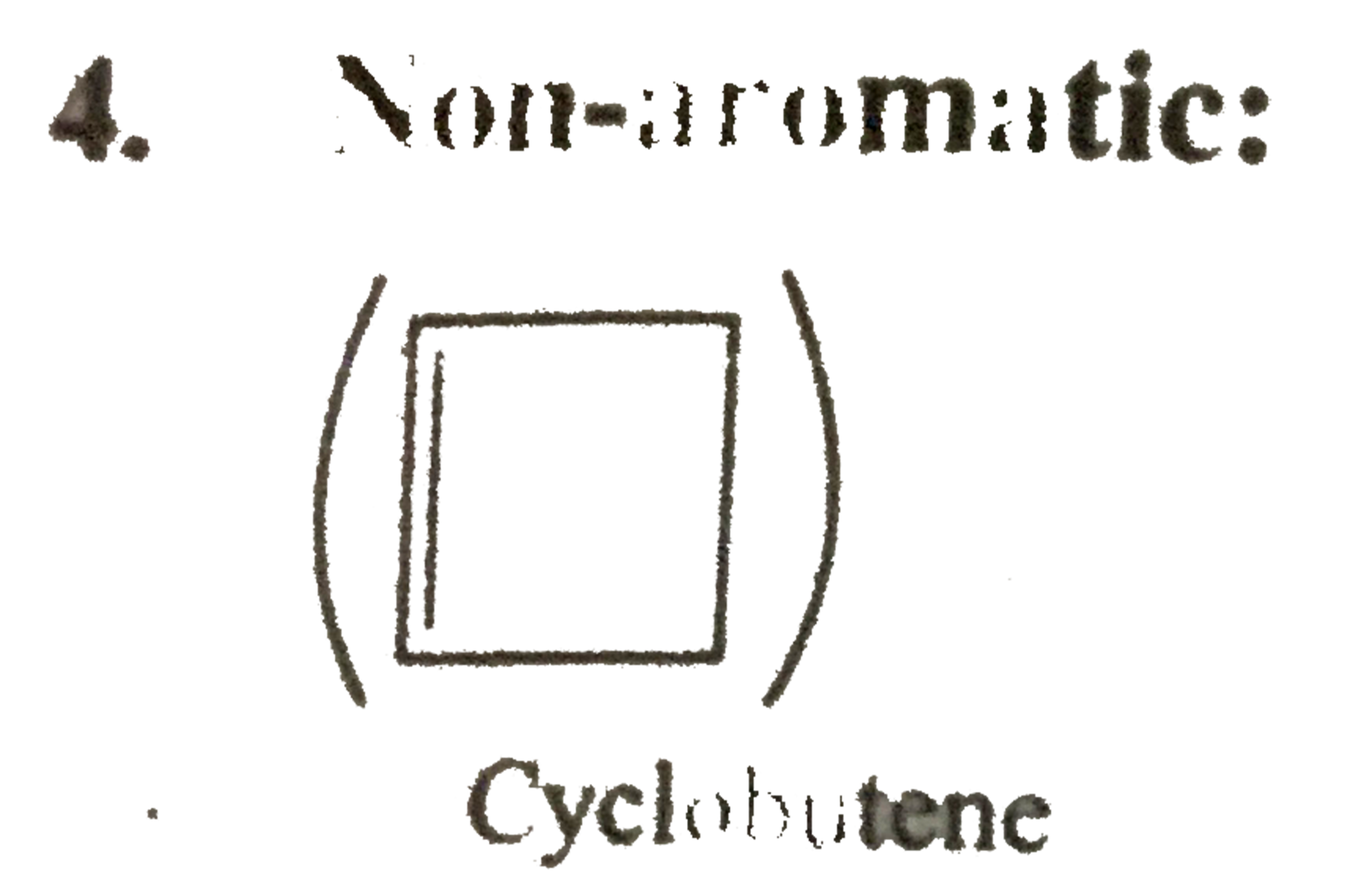 Explained in Section 11.10 (c)<br>5.Non−aromatic:<br><imga≤ocr_imageload∈g=lazysrc=https://d10lpgp6xz60nq.cloudfront.net/physics_images/KSV_CHM_ORG_P2_C11_S01_006_S05.pngwh=80%mx-autosty≤=background:white;>Cyclobutenylcation<br>Cyclic,pla∩ar,2pi vec(e)ssystem,follows(4n + 2) pi vec(e) s, (pi = 0),but2pi vec(e)sare¬∈comp≤te∂ocationwithpositivechar≥.<br>6.Non−aromatic:<br><imga≤ocr_imageload∈g=lazysrc=https://d10lpgp6xz60nq.cloudfront.net/physics_images/KSV_CHM_ORG_P2_C11_S01_006_S06.pngwh=80%mx-autosty≤=background:white;>Cyclobutenylanion<br>Cyclic,nplanar,4pi vec(e)'ssystem(2pi vec(e) + 2 vec(e)omo≠¬ativechar≥)follows4nre–(n = 1)but2pi vec(e)'sare¬∈comp≤te∂ocalisationwith¬ativechar≥.<br>7.Aromatic:<br><imga≤ocr_imageload∈g=lazysrc=https://d10lpgp6xz60nq.cloudfront.net/physics_images/KSV_CHM_ORG_P2_C11_S01_006_S07.pngwh=80%mx-autosty≤=background:white;>Cyclobutenyldirection<br>Cylic,planar@pibar(e)'ssystem,follow∈g(4n+2)re–(n=0),and2pibar(e)'sare∈comp≤te∂ocalisationor∈resonancewithtwopositivechar≥s.<br>8.Aromaitc:<imga≤ocr_imageload∈g=lazysrc=https://d10lpgp6xz60nq.cloudfront.net/physics_images/KSV_CHM_ORG_P2_C11_S01_006_S08.pngwh=80%mx-autosty≤=background:white;>(Cyclobutenyldianion)Cyclic,planar6bar(e)'ssystem[2pibar(e)+4bar(e)'s(omtwo¬ativechar≥s)]follows(4n+2)re–(n=1)ansd2πbae(e) 's are in negitive charges.
Explained in Section 11.10 (c)<br>5.Non−aromatic:<br><imga≤ocr_imageload∈g=lazysrc=https://d10lpgp6xz60nq.cloudfront.net/physics_images/KSV_CHM_ORG_P2_C11_S01_006_S05.pngwh=80%mx-autosty≤=background:white;>Cyclobutenylcation<br>Cyclic,pla∩ar,2pi vec(e)ssystem,follows(4n + 2) pi vec(e) s, (pi = 0),but2pi vec(e)sare¬∈comp≤te∂ocationwithpositivechar≥.<br>6.Non−aromatic:<br><imga≤ocr_imageload∈g=lazysrc=https://d10lpgp6xz60nq.cloudfront.net/physics_images/KSV_CHM_ORG_P2_C11_S01_006_S06.pngwh=80%mx-autosty≤=background:white;>Cyclobutenylanion<br>Cyclic,nplanar,4pi vec(e)'ssystem(2pi vec(e) + 2 vec(e)omo≠¬ativechar≥)follows4nre–(n = 1)but2pi vec(e)'sare¬∈comp≤te∂ocalisationwith¬ativechar≥.<br>7.Aromatic:<br><imga≤ocr_imageload∈g=lazysrc=https://d10lpgp6xz60nq.cloudfront.net/physics_images/KSV_CHM_ORG_P2_C11_S01_006_S07.pngwh=80%mx-autosty≤=background:white;>Cyclobutenyldirection<br>Cylic,planar@pibar(e)'ssystem,follow∈g(4n+2)re–(n=0),and2pibar(e)'sare∈comp≤te∂ocalisationor∈resonancewithtwopositivechar≥s.<br>8.Aromaitc:<imga≤ocr_imageload∈g=lazysrc=https://d10lpgp6xz60nq.cloudfront.net/physics_images/KSV_CHM_ORG_P2_C11_S01_006_S08.pngwh=80%mx-autosty≤=background:white;>(Cyclobutenyldianion)Cyclic,planar6bar(e)'ssystem[2pibar(e)+4bar(e)'s(omtwo¬ativechar≥s)]follows(4n+2)re–(n=1)ansd2πbae(e) 's are in negitive charges.
9. Non-aromatic:  (Cycopenta −1,3− diene)
(Cycopenta −1,3− diene)
Cyclic, planar 4π¯e 's system, follows 4nrule (n=1) ,. and 4π¯e 's are mot in complete deloalisation or not in resonance.
10. Antiaromatic:  (Cyclopenta −1,3− dienyl cation)
(Cyclopenta −1,3− dienyl cation)
Cylic, planar, 4π¯e 's system, follows 4n rule (n=1) , and 4π¯e 's are in complete delocalisation or in resonance with positive charge.
11. Aromatic:  (Cyclopentea −1,3− dienyl anion)
(Cyclopentea −1,3− dienyl anion)
Cycilc, planar 6¯e 's system (4π¯e 's+2bar(e)'somo≠¬ativechar≥)follows(4n+2)re–(n=1),and4pibar(e)'sare∈comp≤te∂oclisationor∈resonanacewith¬ativechar≥.<br>12.Aromatic:<imga≤ocr_imageload∈g=lazysrc=https://d10lpgp6xz60nq.cloudfront.net/physics_images/KSV_CHM_ORG_P2_C11_S01_006_S012.pngwh=80%mx-autosty≤=background:white;>(Benze≠)<br>Cyclic,Planar,6pibar(e)'ssystem,follows(4n+2)re–(n=1),6pibar(e)'sare∈comp≤te∂ocalisationor∈resonace.<br>13.Non−aromatic:<imga≤ocr_imageload∈g=lazysrc=https://d10lpgp6xz60nq.cloudfront.net/physics_images/KSV_CHM_ORG_P2_C11_S01_006_S013.pngwh=80%mx-autosty≤=background:white;>(Cyclohepta-1,3,5-trie≠)<br>Cyclicplanar,6pibar(e)'ssystem,follows(4n+2)re–(n=1),but6pibar(e)'sare¬∈comp≤te∂ocalisationor¬∈resonance.<br>14.Aromatic:<br><imga≤ocr_imageload∈g=lazysrc=https://d10lpgp6xz60nq.cloudfront.net/physics_images/KSV_CHM_ORG_P2_C11_S01_006_S014.pngwh=80%mx-autosty≤=background:white;>Cyclohepta-1,3,5-trienlycation<br>Cyclic,planar6pibar(e)'ssystem,follows(4n+2)re–,(n=1),and6pibar(e)are∈comp≤te∂ocalisationor∈resonancewithpositvechar≥.<br>15.<imga≤ocr_imageload∈g=lazysrc=https://d10lpgp6xz60nq.cloudfront.net/physics_images/KSV_CHM_ORG_P2_C11_S01_006_S015.pngwh=80%mx-autosty≤=background:white;>Cyclohepta-1,3,5-trienlyanion<br>Cyclic,pla∩er8vec(e) ssystem(6pi vec(e) + 2 vec(e)omo≠¬ativechar≥)follows4nre–(n = 2),and6pi vec(e) sare∈comp≤te∂ocalisationor∈resonanancewtih¬ativechar≥.<br>16.Aromatic:<br><imga≤ocr_imageload∈g=lazysrc=https://d10lpgp6xz60nq.cloudfront.net/physics_images/KSV_CHM_ORG_P2_C11_S01_006_S16.pngwh=80%mx-autosty≤=background:white;><br>Cyclic,pla∩er,6pi, vec(e) softher∈g,follows(4pi + 2)re–(n = 1)and6pi vec(e)are∈comp≤te∂ocalisationor∈resonancewithpositivechar≥onther∈g.<br>17.Aromatice:<br><imga≤ocr_imageload∈g=lazysrc=https://d10lpgp6xz60nq.cloudfront.net/physics_images/KSV_CHM_ORG_P2_C11_S01_006_S17.pngwh=80%mx-autosty≤=background:white;><br>Neithercyclophertariencenorcycloperntadiencealo≠isaromaticbutresonanacestructurebearsapositivechar≥∈thesecen−memberedr∈g,givenitanaromaticcharacterofcycloherpratrientylcation,whi≤thefive−memberedr∈gbearsa¬ativechar≥mak∈gitsimilar→thearomaticcyclopentadienty1a→mcyclopentadiencyaanion.Thiscahr≥seprationisreponsib≤fortheobserveddipo≤moment.Moreover,itiscyclic,pla∩erwith10pi vec(e)sare∈comp≤tedecolaiationor∈resonance.<br>18.Aromatic:<br><imga≤ocr_imageload∈g=lazysrc=https://d10lpgp6xz60nq.cloudfront.net/physics_images/KSV_CHM_ORG_P2_C11_S01_006_S18.pngwh=80%mx-autosty≤=background:white;><br>Cyclicpla∩er,6 vec(e)ssystem(4pi vec(e)'s + 2 vec(e)omonlyo≠I.P)(onlylo≠pairisrequiredfor∂ocalisation).Follows(4pi + 2)re–(n = 2), 4pi vec(e)sand2 vec(e)'somLpare∈comp≤te∂ocalistaionor∈resonancehencearomatic.<br>19.Aromatic:<br><imga≤ocr_imageload∈g=lazysrc=https://d10lpgp6xz60nq.cloudfront.net/physics_images/KSV_CHM_ORG_P2_C11_S01_006_S19.pngwh=80%mx-autosty≤=background:white;><br>Sameexplanationas∈18.<br>20.Aromatic:<br><imga≤ocr_imageload∈g=lazysrc=https://d10lpgp6xz60nq.cloudfront.net/physics_images/KSV_CHM_ORG_P2_C11_S01_006_S20.pngwh=80%mx-autosty≤=background:white;><br>Sameexplanationas∈18.<br>21.Aromatic:<br><imga≤ocr_imageload∈g=lazysrc=https://d10lpgp6xz60nq.cloudfront.net/physics_images/KSV_CHM_ORG_P2_C11_S01_006_S21.pngwh=80%mx-autosty≤=background:white;><br>(Lo≠pairvec(e)'sare¬used∈∂ocalisation)<br>Sameexplanationas∈18.<br>22.Aromatic:<br><imga≤ocr_imageload∈g=lazysrc=https://d10lpgp6xz60nq.cloudfront.net/physics_images/KSV_CHM_ORG_P2_C11_S01_006_S22.pngwh=80%mx-autosty≤=background:white;><br>Cylclic,pla∩er,10pi vec(e)'ssystem,follows(4n + 2)re–(n + 2)∈comp≤te∂ocalisationor∈resonance<br>23.Aromatic:<br><imga≤ocr_imageload∈g=lazysrc=https://d10lpgp6xz60nq.cloudfront.net/physics_images/KSV_CHM_ORG_P2_C11_S01_006_S23.pngwh=80%mx-autosty≤=background:white;><br>Cylic,pla∩er,14pi vec(e)'ssystemfollows(4n + 2)re–(n = 3),∈comp≤te∂ocalisi→norresosnance.<br>24.Aromatic:<br><imga≤ocr_imageload∈g=lazysrc=https://d10lpgp6xz60nq.cloudfront.net/physics_images/KSV_CHM_ORG_P2_C11_S01_006_S22.pngwh=80%mx-autosty≤=background:white;><br>Sameexplanationas∈23.Cyclicpaln≠r,2pi vec(e)'softher∈g∈comp≤te∂ocalisationor∈resonancewithpositivechar≥onther∈g,follows(4n + 2)re–(n = 0).<br>26.Anti−aromatic(overset(o+)(C)_(9) H_(9)):

Cyclic, planar, 8π→e's system follows 4n rule (n=2) and 8π→e'sare∈comp≤te∂ocalisationor∈resonancewithpositivechar≥.<br>27.Aromic(overset(o-)(C)_(9) H_(9)):<br><imga≤ocr_imageload∈g=lazysrc=https://d10lpgp6xz60nq.cloudfront.net/physics_images/KSV_CHM_ORG_P2_C11_S01_006_S27.pngwh=80%mx-autosty≤=background:white;><br>Cyclicplanar,10 vec(e)'ssystem[8pi vec(e)'s + 2 vec(e)omo≠¬ativchar≥)],follows(4n + 2)re–(n = 2),and8pi vec(e)'sare∈complate∂ocalisationor∈resonancewith¬ativechar≥.<br>28.Non−aromatic(C_(9) H_(10)):<br><imga≤ocr_imageload∈g=lazysrc=https://d10lpgp6xz60nq.cloudfront.net/physics_images/KSV_CHM_ORG_P2_C11_S01_006_S28.pngwh=80%mx-autosty≤=background:white;><br>Cyclic,planar,8pi vec(e)'ssystem,follows4nre–(n = 2),buttehyare¬∈comp≤te∂ocalisationor¬∈resonance.<br>29.Aromatic:<br><imga≤ocr_imageload∈g=lazysrc=https://d10lpgp6xz60nq.cloudfront.net/physics_images/KSV_CHM_ORG_P2_C11_S01_006_S29.pngwh=80%mx-autosty≤=background:white;><br>Cyclic,pla∩er,⊥hNandBaresp^(2) - hybridised. Each N has two bonding →e's(LP→e's) in a P- orbital and each B has an emply p-orbital, giving a total of six' delocalises, π→e's, hence aromatic, All (B−N) bond lenghths are equal an all ring angles are 120∘.
30. Aromatic: 
In isolated benene rings, π→e's are counted seperately in each ring unlike the fused rings, in whcih total π→e's are counted to verify (4n+2) or 4n rule.
In biphenyl, each ring has six π→e's in delocalsation, hence aromatic.
31. Aromatic: 
Ring (I) has six π→e's in delocalisation and is aromatic. But rign (II) has only two π→e's but not in delocalisation, so ring (II) is non-aromatic. In isolated ring. If one ring is aromatic the compound is said to be aromatic.
32. Aromatic:

Ring (1) has six π→e's in deloclisationand is aromatic. But ring (ii) has only four π→e's but not is delocalisation and is non-armatic. But at least one ring is aromatic, so the compound is armotic.
33. Aromatic: 
same explanation as in 30−32.
34. Non-armatic:

It is not planer but tub-shaped. The p-orbits of one C=C) are not coplaner with those of a negihbouring (C=C) and there can be no effective overlap for delocalisation. The 8π→e's system follows 4n rule (n=2), but due to non-planar, it is not anti-aromonic.
35. Anti-aromatic:
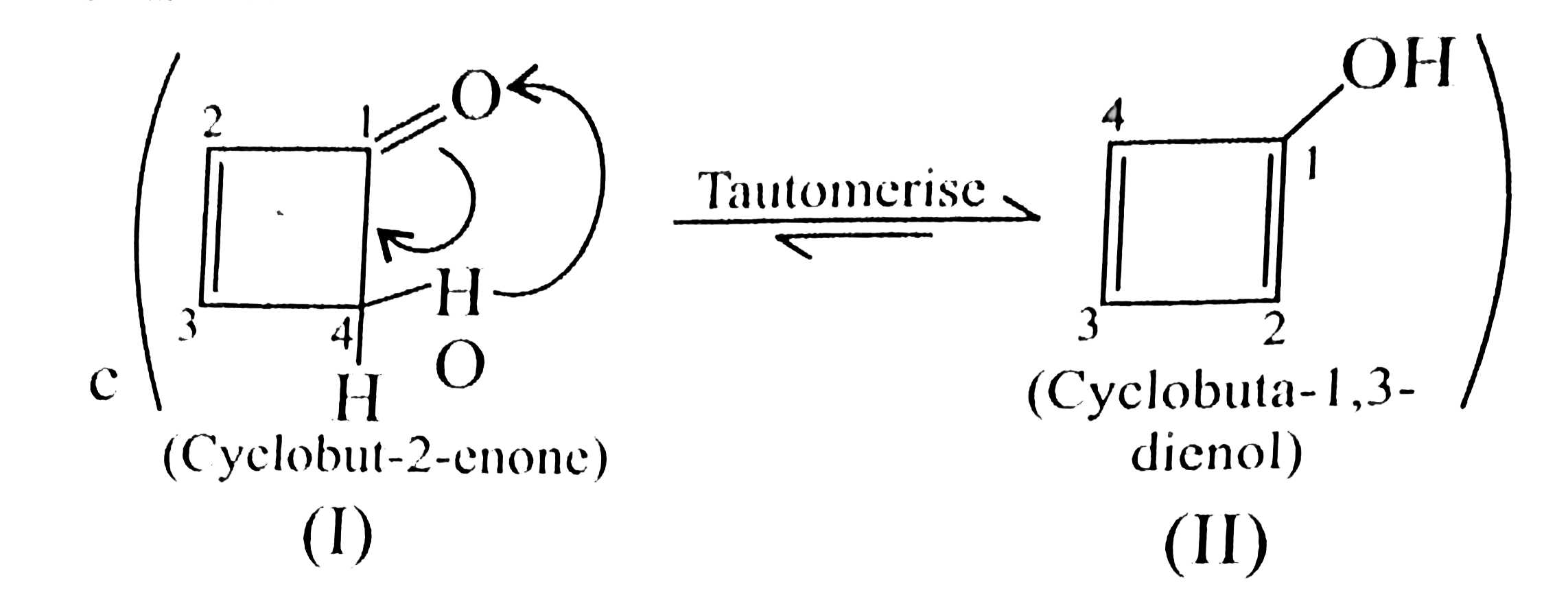
(II) is 4π→e's system in conjugation with complete delocalisation, follows 4n rule (n=1), adn is anti-aromatic.
36. Aromatic:
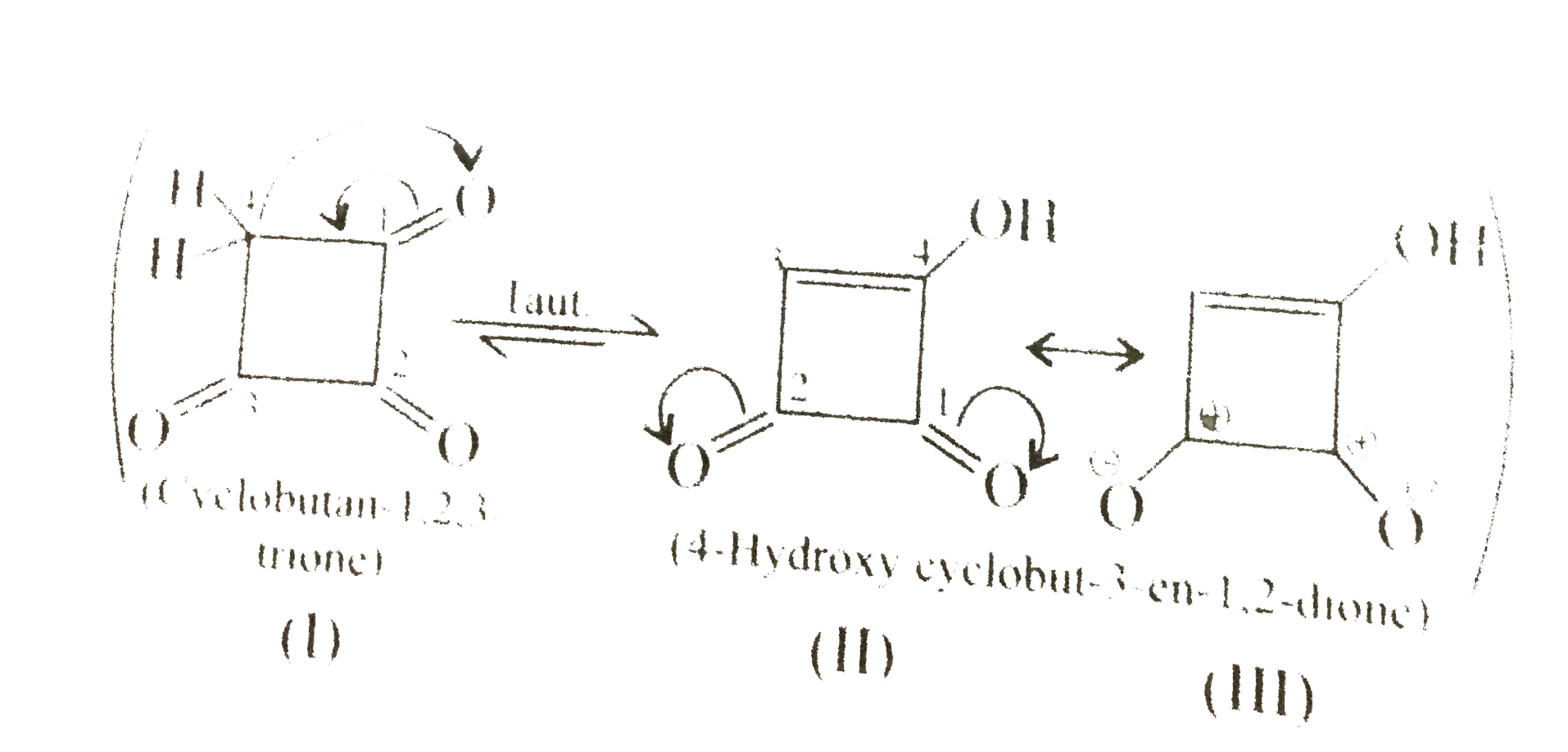
(III) is cyclic, plannar, 2π→e's system and in complete delocalisation wtih two positive charges on the ring (similar to cyclobutenyl dication). It follows (4n+2) rule (n=0).
37. Aromactic:

Neither the five-membered not the seven-membered ring alone is aromatic character of cycloheptatrieny' cation, while the five-membered ring bears a negative charge making it similar to the aromatic cyclopentadienyl anion. This charge separation is reponsible for the observed dipole moment. Further, each ring is aromatic.
38. Aromatic:

Same explanation as in 37.
39: Anti-aromatic: 8→e's system (6π→e's+2→e's from LP on N) in complete delocalisation, cyclic,planar adn follows 4n rule (n=2).
40. Non-aromatic: 4→e system but not in compelete delocalisation, cylic palnar.
41. Aromatic:
10π→e system, in complete delocalisation, cycle plannar. In [10] annulene, interaction by the internal H atoms prevents it from achieving copanirty. Here in this compound. If atoms are replaced by methylene bridge (−CH2−) above the ring, which makes it palnner.
Moreover, bridgehead C atoms are still sp2− hybridised and theri →e's are available for extended delocalisation. Hence, aromatic.
|
Topper's Solved these Questions
- AROMATIC COMPOUNDS AND ALKYL AND ARYL HALIDES BOOK - CENGAGE CHEMISTRY ENGLISHCHAPTER - AROMATIC COMPOUNDS AND ALKYL AND ARYL HALIDES EXERCISE - Solved Examples
21 Videos
- AROMATIC COMPOUNDS AND ALKYL AND ARYL HALIDES BOOK - CENGAGE CHEMISTRY ENGLISHCHAPTER - AROMATIC COMPOUNDS AND ALKYL AND ARYL HALIDES EXERCISE - Solved Problems
37 Videos
- APPENDIX INORGANIC VOLUME 2BOOK - CENGAGE CHEMISTRY ENGLISHCHAPTER - APPENDIX INORGANIC VOLUME 2EXERCISE - Short Answer Type
179 Videos
- BIOMOLECULESBOOK - CENGAGE CHEMISTRY ENGLISHCHAPTER - BIOMOLECULESEXERCISE - Exercises Archives (Analytical And Descriptive)
8 Videos
Similar Questions
Knowledge Check
Nitrating agent for aromatic compound may be :
AN2O5BC2H5ONO2CNO2CF3SO3Dall of these
Naphthalene is an aromatic compound.
View SolutionWhich one is not aromatic compound ?
View SolutionThe aromatic compound would be
View SolutionMention the important characteristics of aromatic compounds.
View SolutionThe aromatic compound would be :
View SolutionWhat are the conditions for aromatic compounds.
View SolutionWhich of the following is a non-aromatic compound ?
View Solution

